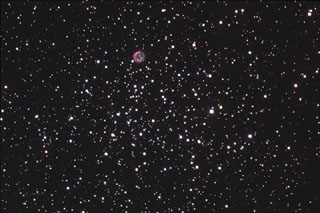It was an exciting moment when the image of this object poured onto my laptop screen for the first time. My previous shot with the ST7E had only the field to record the planetary, and a few surrounding cluster stars. The 8i chip can now show the whole cluster, the planetary, and the surroundings. Photography of open clusters is now a reality. There are two deep sky objects in this image. M46 is the large rich open cluster dominating the field. Rated at 6.1 magnitude, it is a moon sized 27 arcminutes in size. A foreground object is NGC2438, a neat red planetary nebula off to the north, a bright 10.1 magnitude. The central star is very faint, only magnitude 18 and can just be seen in the larger image. The planetary is a large 1 arcminute in size. Why are the stars pinpoints right to the corners with a fast f/5 Newtonian? I use a Lumicon Newtonian coma corrector. Processing: A "synthetic luminance" was created by adding the RGB frames for a low noise L channel. Instrument: 12.5" f/5 Home made Newtonian Platform: Astrophysics 1200 QMD CCD Camera: SBIG ST8i Guider: SBIG ST4 Exposure: LRGB = 40:10:10:20 (Synthetic Luminance) RGB Combine Ratio: 1: .8: 1.2 Filters: RGB Tricolor Location: Payson, Arizona Elevation: 5150 ft. Sky: Seeing FWHM = 3.8 arcsec (Maxim DL - 10min subframe), Transparency 8/10 Outside Temperature: 5 C CCD Temperature: -20 C Processing: Maxim DL, Photoshop, AIP4WIN, PW Pro.
|
||||
|
|
||||
|
FastCounter by bCentral |
